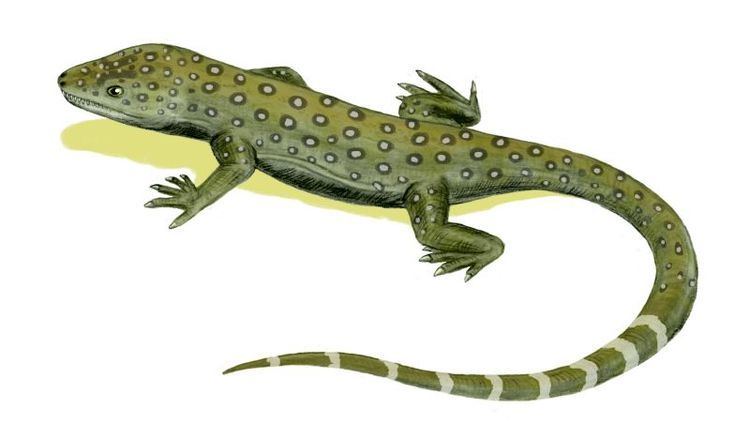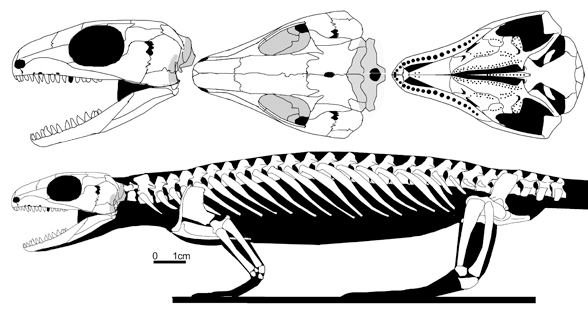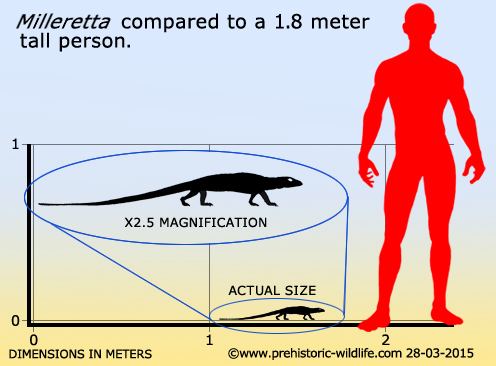Scientific name Milleretta rubidgei Rank Species | Class Reptilia Phylum Chordata | |
 | ||
Genus †MillerettaBroom, 1948 Similar Millerosaurus, Australothyris, Bolosaurus, Bolosauridae, Belebey | ||
Introduction

Milleretta is an extinct genus of millerettid parareptile from the Late Permian of South Africa. Fossils have been found at the Balfour Formation. ’’Milleretta'’ is a moderately sized, lizard-like animal, about 60 centimetres (24 in) in length. It was probably insectivorous. Its only known species is ‘’Milleretta rubidgei’’, making Milleretta a monospecific genus. It is considered the leased derived compared to Milleropsis and Millerosaurus. Huge gaps are at their maximum between the period of ‘’Milleretta’’ as ghost lineages show up. Something attributed to this family is the creation of the lateral temporal opening, which adult Milleretta managed to close completely. It was named by Robert Broom in 1938 and its name means ‘’Miller’s little one’’, as the first ’’Mileretta’’ was a juvenile specimen. The sister taxon is Eunotosaurus. Both taxon were discovered at the Balfour Formation. This suggests that Eunotosaurus lived around the same time and even before ‘’Milleretta’’. As of now, they are considered possibly the oldest in their lineage in the world.(
Contents
The cladogram below displays the phylogenetic position of the Milleretta, from Ruta et al., 2011.
Historical information

When ‘’Milleretta’’ was first discovered and named in 1938, there was only one specimen ever known (specimen number BP/1/3821). B/1/3821 was only a juvenile specimen leaving uncertainty where exactly the juvenile specimen belonged. It wasn’t until 1950, When J.W. Kitching on Wildgebosch farm in New Bethesda, South Africa where an adult ‘’Milleretta’’ was discovered. Specimen number BP/1/2040 was found at the Dicynodon Assemblage zone. The finding at this this zone established the same geographic range compared to other Millerettids. In 1956 Millerrettidae was redefined as a clade closer to ‘’Milleretta rubidgei’’ than to Macroleter poezicus.
Description and Paleobiology

The vertebrae of ‘’Milleretta’’ have wide neural arches, a synapomorhy of their class, parareptilia. It had spines coming off the neural arches. Horizontally orientated zygopophyses are present, as well as prominent transverse processes. BP/1/2040’s adult vertebrae contrast those of the juvenile specimen only with its fused centrum and arch in the adult. The ribs are especially sturdy dorsally, along with caudad expansions that help overlap the next rib over posteriorly. These holocephalus ribs contain crennelations. The thick ribs give protection to the cavity, but decrease the amount of flexibility of the body and decrease swiftness. The sister taxon Eunotosaurus shares thick and overlapped ribs. The thick ribs however are not a synapomorphy of the two taxon, as the ribs’ thickness were acquired them differently. ‘’Milleretta’’ had plesiomorphic vertebrae and made its ribs wider by growing its bone out the shaft to airfoil-like section. In contrast with Eunotosaurus’ trunk vertebrae are stretched and the “T” shaped ribs with double articulations. Not only are the centrum and arch fused, but the pubes and ischia are also fused in its pelvic girdle. Alongside the fused bones, the dorsal blade on the ilium is expanded width-wise. The femur becoming fully ossified, complete formation of articular ends at the limbs, and expanding ribs occur as ‘’Milleretta’’ become adults.
The two specimens of ‘’Milleretta’’ conclude that both lived at the end of the Late-Permian (Changsingian). They’re placement in South Africa gives the possibility of them interacting with other Late-Permian life like Barasaurus. The palate shows a single row of teeth in the palate. The vast range of sharp teeth helped make possible being able to chew insects present at the time.)The presumed great hearing of ’’Milleretta’’ helped them hunt prey by being able to better hear movement. The presumption comes from the two depressions located at the bases of the skull. At first, the depressions brought doubts to whether it was Anapsid. More investigation concluded that the depressions were probably for the eardrums.
‘’Milleretta’’ probably lived in a forest-like environment due to the preserved forest-floor litter finding from the Karoo Basin located in South Africa. During it’s time, ‘’Milleretta’’ had to encounter more seasonally wet conditions providing water, to more arid conditions as it progressed through time. The water around turned to small meandering channels. In a recent examination of soil profiles, the change in vegetation varied around “Milleretta”, which became more dry as time moved on. This change in climate may have played the mass-extinction that happened in the region. Right now, there is still some uncertainty of what the conditions were like, one reason is potentially the is the lack of geochemical studies done in the region.
